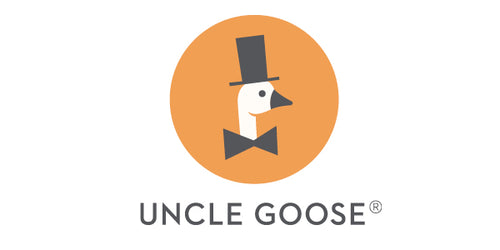
Object Permanence: Why You Continue To Exist During Peekaboo
Not a month goes by where your Uncle Goose doesn’t get the question:
“Why isn’t the first letter of the name of the animal on the opposite side of your ABC blocks?”
Short answer: it’s by design. We avoid putting the first letter of the name of the animal on the opposite side of its illustration. This improves learning outcomes for young children who are learning to spell.
Long answer: in an earlier post, we pointed to the concepts of working memory and cognitive load in instructional design. This month, we’ll address the concepts of object permanence and symbolic thought.
Let’s start with a simple visualization to illustrate the concept of object permanence. Imagine hiding your face behind your hands, then revealing your face to a baby while saying “Peekaboo! Here I am!”
It’s a simple game: but one that fills a baby with delight. That’s because little babies are still working through the concept of object permanence. It’s the idea that even though something is out of sight or reach: it still exists.
As babies age, they become more adept at the idea of objects continuing to exist even if they can’t see or touch them. Developing object permanence is an important building block in developing symbolic thinking.
If you’re reading this, you’ve already mastered both object permanence and symbolic thought. For example, you know that words symbolize things and concepts that may or may not be in the same room with you.
Adults can often take object permanence and symbolic thought for granted. We can forget what it’s like to be a child who is learning to spell. So let’s try another visualization exercise:
In your mind’s eye, conjure up an image of a block. Now picture a fox illustration on one of the six sides. Picture the letters F-O-X underneath your illustration. And lastly, picture the letter F on the opposite side of your imaginary block.
Now use your empathy skills to think like a child that doesn’t know how to spell FOX. Show an imaginary child your imaginary block. Imagine asking the child to spell FOX by using blocks.
What will the child do next? Will they grab the fox block and immediately flip it to the other side to find the F?
No. Of course not. Why would a child start playing peekaboo with a picture of a fox when they’re learning to spell?'
They wouldn’t. Even for an imaginary child, it would be confusing to have an F on the opposite side of the FOX block.
Your imaginary child is more likely to begin searching for the letter F from the remaining blocks. When the child finds the F, they’ll feel a sense of accomplishment before searching for the O, and then the X.
It’s only after you learn how to spell that having the F on the opposite side of the FOX block makes sense. When you’re learning to spell, hiding the letter F can be frustrating.
The FOX illustration paired with its spelling serves as a study and memory aid. By looking at it repeatedly, the child gains even more familiarity with the concept of FOX and its spelling.
When you’re learning to spell, the time for playing peekaboo is over. Instead, this is a time to reduce cognitive load on working memory to strengthen symbolic thinking and improve spelling skills.
At Uncle Goose, we design our ABC blocks with children, fun, and learning in mind. Playing peekaboo is fun when you’re a little baby. But by the time you’re learning to spell; it can be a drag.


